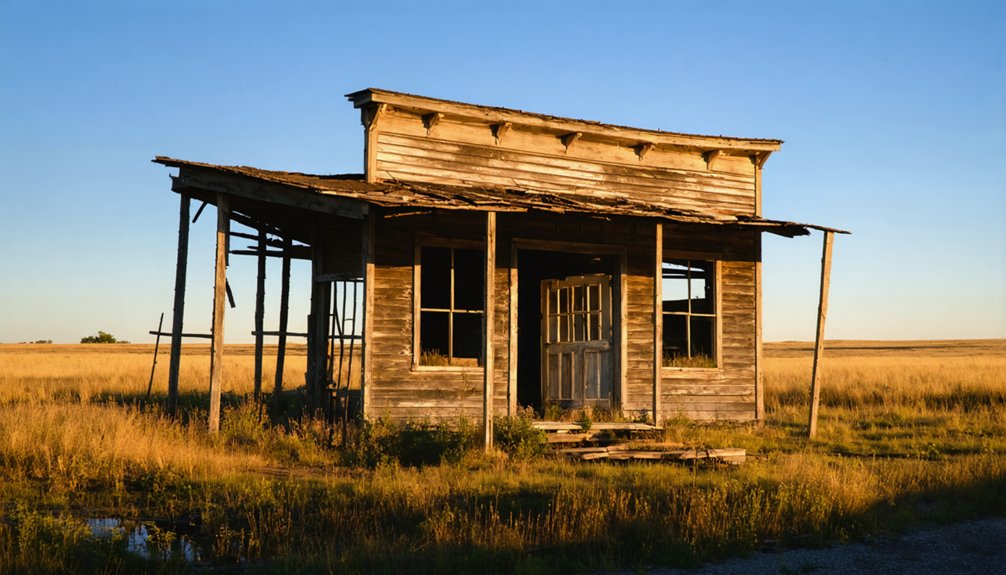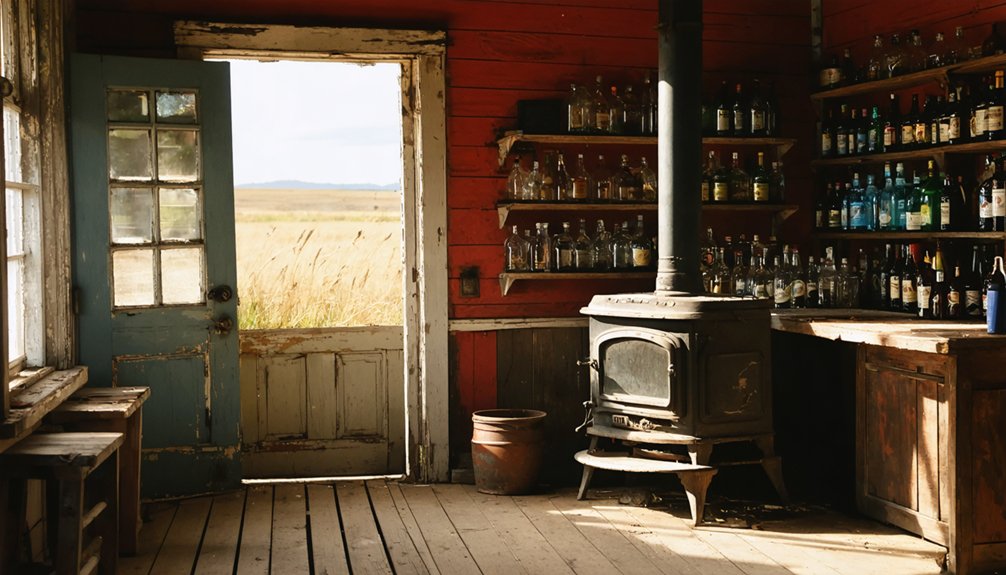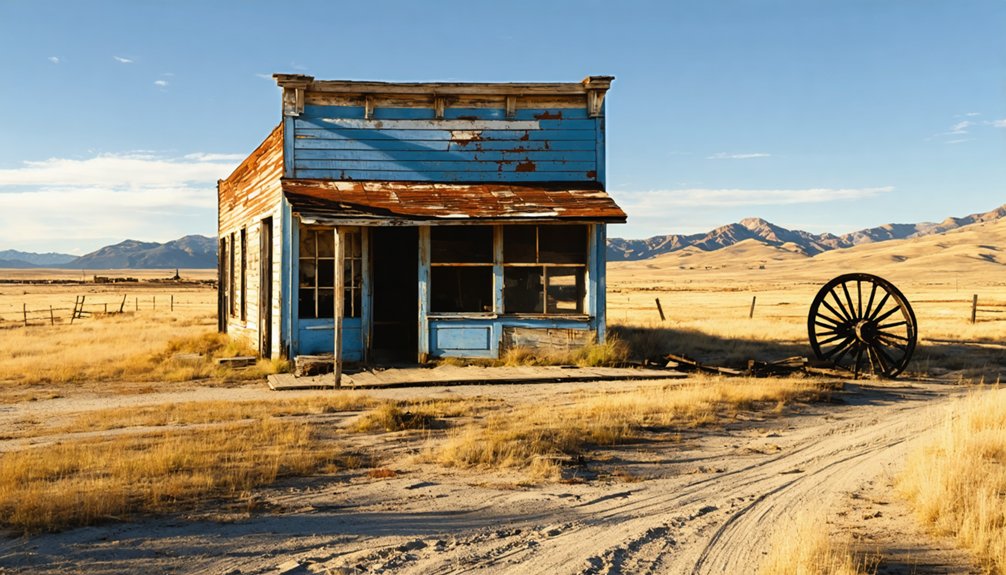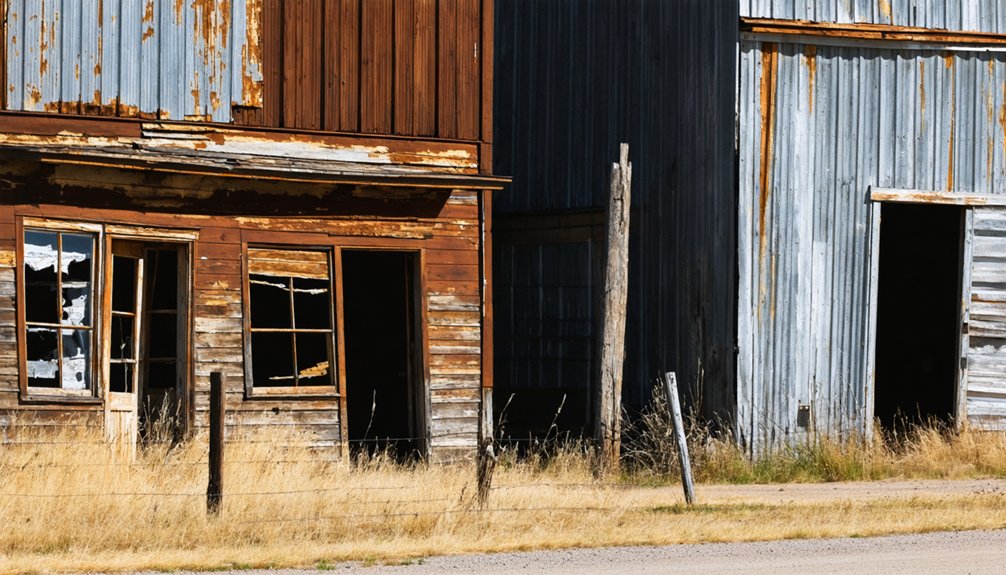You’ll find Sheep’s Tail ghost town nestled in South Dakota’s Black Hills, where the 1870s gold rush sparked a vibrant mining settlement. The community thrived with fewer than 100 residents, featuring landmarks like the Calloway Hotel, Methodist church, and busy Main Street saloons. After uranium and gold resources depleted in the 1950s, the town gradually emptied until its final resident departed in 1972. Today’s weathered structures and mining remnants tell fascinating tales of frontier life.
Key Takeaways
- Sheep’s Tail emerged during the 1870s Black Hills gold rush, evolving into a mining community before becoming abandoned in 1972.
- The town served as a significant mining hub, supporting both gold and uranium operations until resources depleted in the 1950s.
- Historic structures still standing include an 1890s Methodist church, with photographs and documents preserved by the local historical society.
- The ghost town is accessible via Sheep Mountain Table Road, requiring four-wheel drive vehicles and best visited during dry summer months.
- The community peaked with fewer than 100 residents, featuring hotels, saloons, churches, and a schoolhouse during its prosperous mining era.
The Origins and Early Settlement
When prospectors discovered gold in the Black Hills during the 1870s, Sheep’s Tail emerged as one of many hastily established mining settlements in South Dakota’s rugged terrain. The town’s strategic location near mining operations and transportation routes made it an ideal spot for settler motivations centered on striking it rich in the gold rush. Like the historic town of Rockerville, many settlers opened small shops to serve the mining community.
Like many settlers in South Dakota, they were driven by dreams of prosperity and the chance to build new lives in the region. You’ll find that Sheep’s Tail’s early community dynamics reflected the diverse mix of fortune seekers who called it home. While single miners made up much of the population, families also put down roots, establishing the basic framework of a stable community.
They built wooden structures, including cabins and a general store, while experienced pioneers brought valuable skills from nearby settlements. Like many Black Hills communities, they faced harsh living conditions but persevered through isolation and supply challenges.
Life in Sheep’s Tail’s Heyday
As Sheep’s Tail’s mining operations gained momentum, the town evolved into a bustling frontier community during its peak years. You’d find fewer than 100 residents calling this Black Hills settlement home, living in hastily constructed wooden buildings along the main street, including the prominent Calloway Hotel. The town’s proximity to Camp Warren’s military post offered some protection for early settlers.
Life centered around community gatherings in the saloons and hotel halls, where you could enjoy dancing and music after long days in the mines. Just like in Scenic’s early days, traders and trappers regularly passed through, adding to the town’s frontier character.
Daily hardships were constant companions – brutal winters, limited medical care, and the ever-present uncertainty of mining success. You’d need to carefully manage your supplies, which arrived by rail or wagon, and weather the economic ups and downs that came with frontier life.
Despite these challenges, the town’s residents forged a tight-knit community, bound together by their shared struggles and hopes.
Economic Activities and Industries
When you visit Sheep’s Tail today, you’ll find remnants of what was once a bustling hard rock mining town, where shaft houses and ore processing facilities dominated the landscape through the late 1800s.
Like many settlements in the region during mining boom times, saloons and entertainment venues sprung up to serve the growing population.
The town’s strategic location made it an important railroad supply hub, with trains delivering essential mining equipment and hauling away precious minerals extracted from the surrounding Black Hills. Like other South Dakota towns with grain elevators, this infrastructure played a vital role in the local economy.
Beyond mining, Sheep’s Tail supported a thriving livestock trade, where local ranchers would bring their cattle to be shipped by rail to larger markets in the Midwest.
Mining and Mineral Resources
Mining played an essential role in Sheep’s Tail’s regional development, particularly through uranium and gold extraction activities. The area’s mining legacy began with the Black Hills Gold Rush of 1874-1877, while uranium operations emerged in 1957, producing 69,632 tons in its first year. During this period, thousands of illegal prospectors flooded into the territory despite government restrictions.
You’ll find Sheep’s Tail situated near significant mining developments in Fall River County at 3,980 feet elevation. The region’s most prominent operation, Homestake Mining Company, was purchased for seventy thousand dollars in 1877.
Key mining developments in the region included:
- Uranium mining operations that transformed Fall River County’s economy
- Gold extraction activities that sparked the initial settlement boom
- The nearby Homestake Mine’s production of 40+ million troy ounces until 2002
- Implementation of environmental regulations in the 1990s to control mining impact
Despite coal deposits in the region, coal mining never gained significant traction near Sheep’s Tail, remaining limited to small-scale operations.
Railroad Supply Hub
Throughout the 1890s, Sheep’s Tail emerged as an indispensable railroad supply hub along the Chicago, Burlington & Quincy (CB&Q) branch line near Edgemont. The town’s railroad logistics centered around a bustling depot that handled telegraph communications, mail services, and freight operations. Following the common T-shape layout, streets and buildings were organized with the commercial district perpendicular to the railway tracks.
You’d have found a vibrant supply chain ecosystem with grain elevators, warehouses, and stockyards facilitating the movement of agricultural products from local farmers to national markets. Like many railroad-driven communities, the town’s economic success relied heavily on shipping and transportation networks.
The railroad brought essential resources like coal, wood, and building materials to support the region’s growth. Local businesses, including general stores, blacksmiths, and hotels, clustered near the depot to serve both residents and travelers.
Despite challenges with local water supplies, Sheep’s Tail’s strategic position on the CB&Q line made it a significant waypoint for the area’s economic development.
Livestock Trading Center
A bustling hub of livestock commerce transformed Sheep’s Tail into one of South Dakota’s prominent trading centers during the late 1880s.
You’d have found the town thriving with economic stability through its diverse livestock trading operations, especially after the expansion that followed the Yankton Treaty of 1858.
The town’s success as a trading center was marked by:
- Extensive wool warehouses for grading and weighing premium Corriedale and Rambouillet fleeces
- Strategic location along river trade routes that connected to major railheads
- Year-round employment opportunities for skilled animal handlers and traders
- Multiple stockyards serving both sheep and cattle operations
The town’s infrastructure development mirrored South Dakota’s broader agricultural evolution, with facilities designed to handle market fluctuations and changing livestock needs that kept the local economy resilient.
Notable Buildings and Landmarks

Life in Sheep’s Tail centered around its bustling Main Street, where several key commercial buildings stood during the town’s heyday in the late 19th century.
Main Street was the heart of Sheep’s Tail, lined with thriving businesses during its prosperous peak in the 1800s.
You’ll find historic architecture in the remains of general stores and saloons that once served miners and travelers. The original saloon, despite legal challenges around alcohol sales, functioned as the town’s primary social hub.
Two churches – Methodist and Catholic – showcase the community landmarks that defined daily life. The community hall hosted town meetings, while hotels provided lodging for the constant stream of workers during the mining boom.
Public bathhouses and a schoolhouse reflected the town’s commitment to resident services. Along side streets, wooden-frame homes from the early 1900s still stand, though many now show their age.
The Decline and Abandonment
When mineral resources began to run dry in the early 1950s, Sheep’s Tail’s fate was sealed. The economic impacts rippled through the community as mining operations ceased, triggering devastating changes to local businesses and community dynamics.
By 1955, the railroad had abandoned its tracks, effectively cutting off the town’s lifeline to the outside world.
The town’s collapse unfolded in rapid succession:
- Mass exodus of skilled workers and young families by 1957
- Closure of the general store and post office in 1961
- Shutdown of the last operational church in 1965
- Final resident’s departure in 1972
Harsh winters, environmental degradation from mining, and the remote location deterred any hopes of economic diversification.
Today, Sheep’s Tail stands as a symbol of the boom-and-bust cycle of mining towns in South Dakota.
Preserved Artifacts and Structures

Scattered remnants of Sheep’s Tail’s past lie frozen in time across the abandoned landscape.
You’ll find artifact preservation efforts focused on the town’s weathered structures, including the 1890s Methodist church and former general store, which still maintain their structural integrity despite decades of exposure to South Dakota’s harsh elements.
As you explore the site, you’ll discover historical items carefully preserved in the remaining buildings – from farming implements to household goods that tell the story of frontier life.
While many structures remain under private ownership, you can still view several community buildings that served as gathering places.
The local historical society maintains a collection of photographs and documents from 1885-1920, providing glimpses into the daily lives of the townspeople who once called this prairie settlement home.
Getting to Sheep’s Tail Today
You’ll need a reliable four-wheel drive vehicle to reach Sheep’s Tail via Sheep Mountain Table Road, which branches off SD Highway 27 about 4.5 miles south of Scenic.
The best times to visit are during dry summer months when the dirt roads remain passable, though you should always check current conditions before departing from Rapid City or other Black Hills hubs.
Before setting out, stock your vehicle with essential supplies including offline maps, extra water, basic off-road equipment, and emergency communication devices, as cell service is extremely limited in this remote section of South Dakota’s badlands.
Road Conditions and Access
Reaching Sheep’s Tail today requires careful preparation and the right vehicle for challenging terrain.
Road maintenance ends several miles before the site, leaving you to navigate unmaintained paths that demand four-wheel drive capabilities. You’ll find primarily gravel and dirt roads, which become increasingly rugged as you approach the ghost town.
To successfully reach Sheep’s Tail, you’ll need:
- Four-wheel drive or all-wheel drive vehicle with appropriate tires
- GPS navigation and physical maps due to minimal signage
- Extra fuel, water, and emergency supplies
- Updated weather information to avoid impassable conditions
During winter months, snow can block access entirely, while spring thaws create muddy conditions that challenge even well-equipped vehicles.
You’ll want to time your visit during summer or fall for ideal vehicle suitability and road conditions.
Best Times to Visit
When planning your visit to Sheep’s Tail, timing can make all the difference in both accessibility and experience quality. The best visiting window runs from May through October, offering reliable access and comfortable conditions for exploring the ruins.
Spring brings moderate temperatures and wildflowers, while summer delivers warmth but larger crowds. Fall’s cooler weather and colorful foliage create an especially atmospheric backdrop for photography.
For ideal experiences, schedule your arrival during daylight hours, particularly in early morning or late afternoon when lighting conditions excel for photos.
You’ll find seasonal activities throughout the year, from spring wildlife watching to autumn historical reenactments in nearby towns. Just avoid winter months, when snow and ice can make roads treacherous, and skip rainy days when muddy paths might limit site access.
Essential Travel Supplies
Successful exploration of Sheep’s Tail requires thorough preparation and essential gear due to its remote South Dakota location.
With no nearby services and limited cell coverage, your wilderness survival skills and emergency preparedness will be vital for a safe visit to this historic site.
Pack these essential items before heading out:
- Navigation tools – offline GPS device, physical maps, and compass
- Safety equipment – first aid kit, emergency blanket, satellite phone or personal locator beacon
- Basic supplies – water, food, flashlight, multi-tool, and weather-appropriate clothing
- Photography gear – camera with extra batteries, protective case, and tripod
You’ll need a high-clearance vehicle, preferably with four-wheel drive, to navigate the unpaved roads.
Remember to fill your gas tank before departure, as there aren’t any fuel stations near Sheep’s Tail.
Photography and Exploration Tips
To capture Sheep’s Tail ghost town’s haunting beauty, you’ll need to strategically plan your photography and exploration. Visit during golden hour – early morning or late afternoon – when the Black Hills’ natural light creates dramatic shadows across weathered structures.
Pack a wide-angle lens for sweeping landscape shots and a telephoto for architectural details.
When exploring, stick to established paths and keep a safe distance from unstable buildings. You’ll want sturdy hiking boots and weather-appropriate gear, as the terrain near Sheep Mountain can be challenging.
Bring essential exploration gear including a GPS device, first aid kit, and plenty of water.
For the best photography techniques, use neutral density filters to manage harsh sunlight, and pack a tripod for low-light conditions.
Remember to protect your camera from dust and always carry lens cleaning supplies.
Historical Significance in South Dakota

Sheep’s Tail ghost town stands as a tribute to South Dakota’s dynamic Gold Rush era, which transformed the Black Hills region after 1874.
Like many settlements of its time, this ghost town embodies the cultural heritage of a region shaped by ambitious prospectors, diverse immigrant communities, and the untamed spirit of the American frontier.
The town’s historical significance is reflected in:
- Its role during the Black Hills mining boom, showcasing the region’s economic transformation
- The preserved remnants that tell stories of ghost town legends and pioneer life
- Its representation of the boom-and-bust cycle that defined many South Dakota mining communities
- The site’s importance as a testament to the resilience of early settlers who battled harsh terrain and isolation
These elements continue to draw history enthusiasts and preserve an important chapter in South Dakota’s past.
Frequently Asked Questions
Are There Any Documented Paranormal Activities or Ghost Stories From Sheep’s Tail?
Ever wonder what spirits linger in forgotten towns? You won’t find documented ghost sightings or haunted locations in Sheep’s Tail – despite its ghost town status, there’s no verified paranormal activity on record.
What Native Tribes Originally Inhabited the Area Before Sheep’s Tail Was Established?
You’ll find that primarily Lakota Sioux peoples inhabited this region, with their tribal traditions deeply rooted in the Black Hills area. Western Dakota (Yankton) and Nakota groups also claimed historical presence.
Did Any Famous Outlaws or Historical Figures Ever Visit Sheep’s Tail?
While famous visitors like Dillinger and Ma Barker feature in regional outlaw legends, you won’t find concrete evidence of any notorious figures actually visiting Sheep’s Tail – those stories remain unverified myths.
What Happened to the Cemetery and Are There Still Marked Graves?
You’ll find the cemetery’s largely reclaimed by nature, with minimal preservation efforts. While some weathered grave markers remain visible, most are eroded or missing entirely due to decades of neglect and occasional vandalism.
Were There Any Major Disasters or Epidemics That Affected Sheep’s Tail?
Like whispers lost to prairie winds, you won’t find concrete records of epidemic impact or disaster response in Sheep’s Tail, though nearby towns battled harsh blizzards and the 1919 flu.
References
- https://www.youtube.com/watch?v=Glucs_Rq8Xs
- https://www.powderhouselodge.com/black-hills-attractions/fun-attractions/ghost-towns-of-western-south-dakota/
- https://www.southdakotamagazine.com/scenic
- https://www.sdpb.org/rural-life-and-history/2023-08-21/some-black-hills-ghost-towns-and-their-origins
- https://www.youtube.com/watch?v=_0WNYsFLSLA
- https://www.blackhillsbadlands.com/blog/post/old-west-legends-mines-ghost-towns-route-reimagined/
- https://en.wikipedia.org/wiki/List_of_ghost_towns_in_South_Dakota
- https://icatchshadows.com/okaton-and-cottonwood-a-photographic-visit-to-two-south-dakota-ghost-towns/
- https://openprairie.sdstate.edu/etd/4061/
- https://www.sdhspress.com/journal/south-dakota-history-2-2/some-black-hills-ghost-towns-and-their-origins/vol-02-no-2-some-black-hills-ghost-towns-and-their-origins.pdf



